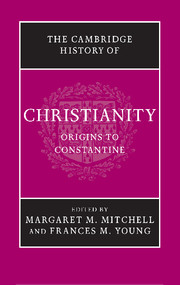Book contents
- Frontmatter
- Prelude: Jesus Christ, foundation of Christianity
- Part I The Political, Social and Religious Setting
- Part II The Jesus Movements
- Part III Community Traditions and Self-Definition
- 8 The emergence of the written record
- 9 Marcion and the ‘canon’
- 10 Self-definition vis-à-vis the Jewish matrix
- 11 Self-definition vis-à-vis the Graeco-Roman world
- 12 Self-differentiation among Christian groups: the Gnostics and their opponents
- 13 Truth and tradition: Irenaeus
- 14 The self-defining praxis of the developing ecclēsia
- Part IV Regional Varieties of Christianity in the First Three Centuries
- Part V The Shaping of Christian Theology
- Part VI ‘Aliens’ become Citizens: towards Imperial Patronage
- Conclusion: retrospect and prospect
- Bibliographies
- Index
- Map 1. The Roman Empire in the time of Marcus Aurelius
- References
12 - Self-differentiation among Christian groups: the Gnostics and their opponents
from Part III - Community Traditions and Self-Definition
Published online by Cambridge University Press: 28 March 2008
- Frontmatter
- Prelude: Jesus Christ, foundation of Christianity
- Part I The Political, Social and Religious Setting
- Part II The Jesus Movements
- Part III Community Traditions and Self-Definition
- 8 The emergence of the written record
- 9 Marcion and the ‘canon’
- 10 Self-definition vis-à-vis the Jewish matrix
- 11 Self-definition vis-à-vis the Graeco-Roman world
- 12 Self-differentiation among Christian groups: the Gnostics and their opponents
- 13 Truth and tradition: Irenaeus
- 14 The self-defining praxis of the developing ecclēsia
- Part IV Regional Varieties of Christianity in the First Three Centuries
- Part V The Shaping of Christian Theology
- Part VI ‘Aliens’ become Citizens: towards Imperial Patronage
- Conclusion: retrospect and prospect
- Bibliographies
- Index
- Map 1. The Roman Empire in the time of Marcus Aurelius
- References
Summary
When around 180 ce Bishop Irenaeus of Lyons wrote his Detection and refutation of gnōsis falsely so-called, known simply by the Latin title Adversus haereses (‘Against heresies’), he hoped to bring order to a confused situation. A bewildering number of ‘Christian’ groups and teachers offered interested persons salvation, often in the form of gnōsis (‘knowledge’ or ‘acquaintance’) with God. Yet the teachings and practices of these ‘Christians’ displayed an astonishing diversity on such issues as the nature(s) of God and the creator of this world and the content and interpretation of scripture. Irenaeus presented his readers with a powerfully simple way to make sense of these competing claims. There was, he argued, a single consistent Christian truth, deposited in a single church spread throughout the world in communities that could trace their heritage back to Christ and his original apostles. All other groups that claimed to be Christian, despite their seemingly infinite variety, in fact were manifestations of a single error, false gnōsis, which originated in a single teacher, Simon Magus (Acts 8:9–24). The clarity of Irenaeus’ vision is so compelling that even today, after more than a century of scholarship undermining it, we moderns must exert great pains to see the Christianities of the second century in any other way.
- Type
- Chapter
- Information
- The Cambridge History of Christianity , pp. 245 - 260Publisher: Cambridge University PressPrint publication year: 2006
References
- 3
- Cited by



